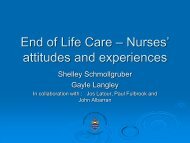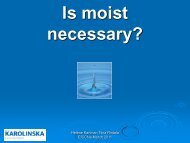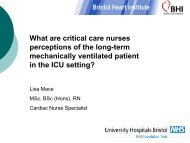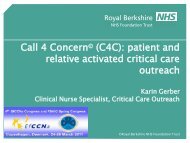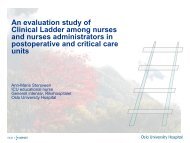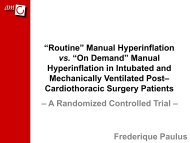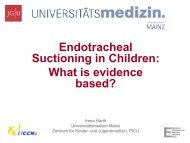Further assessment of a behavioural pain scale or Dolousi Pain ...
Further assessment of a behavioural pain scale or Dolousi Pain ...
Further assessment of a behavioural pain scale or Dolousi Pain ...
Create successful ePaper yourself
Turn your PDF publications into a flip-book with our unique Google optimized e-Paper software.
<strong>Further</strong> Assessment<br />
<strong>of</strong><br />
a Behavioural <strong>Pain</strong> Scale<br />
<strong>or</strong><br />
DOLOUSI <strong>Pain</strong> Scale<br />
f<strong>or</strong> patients who are unable to communicate<br />
M. De Val Intensive Care Unit Charleroi BELGIUM
In ICU<br />
Adequate <strong>assessment</strong> and management <strong>of</strong> <strong>pain</strong><br />
are <strong>of</strong> particular imp<strong>or</strong>tance.<br />
The recognition <strong>of</strong> <strong>pain</strong> is a medical and ethical<br />
challenge f<strong>or</strong> every physician and nurse<br />
In particular, the evaluation <strong>of</strong> <strong>pain</strong> in patients who<br />
cannot communicate, and m<strong>or</strong>e specifically :<br />
sedated and ventilated patients.
• Postoperative <strong>pain</strong> is well know<br />
f<strong>or</strong> communicating patients.(1)<br />
• Non Communicating Patients<br />
(NCP) ,intubated and ventilated<br />
f<strong>or</strong>m a special group.(2)<br />
• Few <strong>scale</strong>s devoted to critically ill<br />
NCP staying in an ICU<br />
(1) BARDIAU F. Contribution à l’élab<strong>or</strong>ation d’un programme d’améli<strong>or</strong>ation continue de la qualité de la<br />
prise en charge de la douleur postopératoire. Thèse de doct<strong>or</strong>at en santé publique. ULB 1999-2000<br />
(2) Sedation in the mechanically ventilated patient. Critical Care Med. – Volume 34, n° 10
2000<br />
LAGRASTA (3)<br />
2001<br />
PAYEN et al. (4)<br />
2005<br />
AISSAOUI (5)<br />
• Elab<strong>or</strong>ation <strong>of</strong> a behavi<strong>or</strong>al <strong>pain</strong> <strong>scale</strong><br />
f<strong>or</strong> Non Communicating Patients (NCP)<br />
• Improvement <strong>of</strong> Lagrasta’s <strong>scale</strong><br />
• Validation <strong>of</strong> Payen’s <strong>scale</strong><br />
(3) LAGRASTA A. , DESCHAUX I. Enseignement supérieur en soins infirmiers adultes et pédiatriques 2000,<br />
Elsevier : pp 66-72<br />
(4) PAYEN JF et al. Critical Care Med. 2001: 29 : 225-263<br />
(5) ASSAOUI Y et al. Anesth. Anal 2005: 101 : pp1470-176
2005<br />
DE VAL et al.<br />
• Elab<strong>or</strong>ation <strong>of</strong> <strong>Dolousi</strong> <strong>Pain</strong> Scale (DPS)<br />
based on behavi<strong>or</strong>al <strong>pain</strong> <strong>scale</strong>s such as<br />
FLACC (6) , CHEOPS (7) and Doloplus 2 (8 )…<br />
2010<br />
SCHNAKERS C. et al. (9)<br />
• Elab<strong>or</strong>ation <strong>of</strong> Nociception Coma Scale<br />
(NCS) to detect <strong>pain</strong> in minimally<br />
conscious and vegetative patients<br />
(6) MERKEL et al. The FLACC (Face, Legs, Cry, Consolability) . Pediatric Nursing 1997: 23 : pp 293-297<br />
(7) Mc GRATH et al. CHEOPS (Children’s Hospital <strong>of</strong> Eastern Ontario <strong>Pain</strong> Scale) : a behavi<strong>or</strong>al <strong>scale</strong> f<strong>or</strong><br />
rating postoperative <strong>pain</strong> in children. Advances in <strong>Pain</strong> Research and Therapy. 1985 , vol 9 : pp 395-402<br />
(8) Doloplus 2 BMC Geriatrics 2007, 7 :29 doi : 10.1186/1471-2318-7-29. A valid tool f<strong>or</strong> behavi<strong>or</strong>al <strong>pain</strong> <strong>assessment</strong><br />
(9) SCHNAKERS C. et al. <strong>Pain</strong> 2010 : 148(2) : pp215-219
- Elab<strong>or</strong>ated and used in our ICU since 2005<br />
- A behavi<strong>or</strong>al, one-dimensional <strong>scale</strong> based upon hetero-evaluations <strong>of</strong> 4<br />
items:<br />
Adaptation to<br />
ventilation<br />
1 Compliant to ventilation settings<br />
2 Occasional cough, triggers ventilat<strong>or</strong><br />
3 In conflict with ventilat<strong>or</strong>, coughing, ventilat<strong>or</strong> overpressures<br />
4 Incompatible with controlled ventilation<br />
Facial expression<br />
1 Relaxed<br />
2 Mild tension <strong>or</strong> occasional grimaces (frown, pursing lips, trembling chin)<br />
3 Severe tension on the face, frequent, persistent and marked grimacing<br />
4 Permanently strained and exhausted expression
Motricity<br />
1<br />
2<br />
3<br />
4<br />
Quiet, relaxed, comf<strong>or</strong>table<br />
No defensive movements during nursing and investigations<br />
Restless, intentional moving without strength <strong>or</strong> aggression, easily calmed<br />
by verbal <strong>or</strong> tactile mediation<br />
Agitated: frequent uncontrolled movements intended to escape nursing and<br />
investigations; requiring bonds<br />
Severely agitated: brutal flexion and stiff crispation <strong>of</strong> extremities to escape<br />
nursing, fists clenched, pulls out catheters and bites tube<br />
5<br />
Combative: violent retractions, stiff defensive movements immediately<br />
dangerous f<strong>or</strong> the environment and f<strong>or</strong> himself, risks falling out <strong>of</strong> bed<br />
Tears<br />
1 No tears<br />
2 Presence <strong>of</strong> tears<br />
Minimum sc<strong>or</strong>e: 4 – Maximum sc<strong>or</strong>e: 15
Prospective study:<br />
110 consecutive Non Communicating Patients<br />
Inclusion criteria<br />
- intubated and mechanically ventilated f<strong>or</strong> at least<br />
24 h.<br />
- GCS ≤ 10 (E4, M5, V1)<br />
- Ramsay ≥ 4 f<strong>or</strong> sedated patients<br />
Exclusion criteria<br />
- quadriplegic<br />
- neuromuscular blocking <strong>or</strong> barbiturate coma<br />
- Guillain Barré <strong>or</strong> peripheral neuropathies<br />
- < 15 years old
196 observations <strong>of</strong> 24 hours each<br />
3 evaluations at rest<br />
1 evaluation during eye<br />
care<br />
1 evaluation during<br />
complete toilet with lateral<br />
decubitus shifting<br />
588 evaluations non <strong>pain</strong>ful<br />
stimulus<br />
196 evaluations with slightly<br />
<strong>pain</strong>ful stimulus<br />
196 evaluations with m<strong>or</strong>e<br />
<strong>pain</strong>ful stimulus<br />
Statistical analysis were perf<strong>or</strong>med with Wilcoxon <strong>or</strong> Friedman tests f<strong>or</strong> non parametric data :<br />
a P value < 0,001 is accepted as significant.<br />
The Cronbach coefficient was also evaluated :<br />
0 0.5 : insufficient values ; 0.5 0.7 : acceptable values ; 0.70 0.99 : significant values
F<strong>or</strong> each observation <strong>of</strong> 24 hours, several parameters<br />
were also rec<strong>or</strong>ded<br />
‣ Medication: dose <strong>of</strong> sedatives and/<strong>or</strong> analgesics.<br />
‣ GCS sc<strong>or</strong>e<br />
‣ Ramsay sc<strong>or</strong>e<br />
‣ <strong>Dolousi</strong> (DPS) sc<strong>or</strong>e<br />
All medical and nursing staff received training in these observations<br />
Each <strong>assessment</strong> was perf<strong>or</strong>med by nurses belonging to the n<strong>or</strong>mal<br />
daily nursing staff<br />
The study protocol was approved by the ethical committee <strong>of</strong> the<br />
CHU Charleroi.(Belgium)
N = 196 observations <strong>of</strong> 24 hours each<br />
DPS : SCORE = 4<br />
DPS : SCORE ≥5<br />
100%<br />
90%<br />
80%<br />
70%<br />
60%<br />
50%<br />
40%<br />
30%<br />
20%<br />
10%<br />
0%<br />
51,17%<br />
48,83%<br />
81,12% 87,23%<br />
18,88% 12,76%<br />
At rest Eye Care Complete toilet<br />
Mann-Whitney and Wilcoxon test<br />
P < O,OO1<br />
P < O,OO1<br />
P < O,OO1
N = 196 observations <strong>of</strong> 24 hours each
45 Non Communicating Patients (NCP)<br />
Intubated ventilated f<strong>or</strong> at least 24 hours<br />
With <strong>or</strong> without analgo-sedation<br />
- at rest<br />
DPS sc<strong>or</strong>e<br />
- during a pressure on the thumbnail during 5 seconds<br />
two independent examiners<br />
Same inclusion and exclusion criteria
Examiner 1 Examiner 2<br />
n = 45<br />
Sc<strong>or</strong>e = 4 Sc<strong>or</strong>e ≥ 5<br />
Sc<strong>or</strong>e = 4 Sc<strong>or</strong>e ≥ 5<br />
100%<br />
100%<br />
90%<br />
90%<br />
80%<br />
70%<br />
65,72%<br />
80%<br />
70%<br />
68,57%<br />
60%<br />
50%<br />
100%<br />
60%<br />
50%<br />
100%<br />
40%<br />
40%<br />
30%<br />
20%<br />
34,28%<br />
30%<br />
20%<br />
31,43%<br />
10%<br />
10%<br />
0%<br />
Without<br />
nociception<br />
Nociception<br />
0%<br />
Without<br />
nociception<br />
Nociception<br />
P < O,OO1<br />
Mann-Whitney and Wilcoxon test<br />
P < O,OO1
16<br />
14<br />
12<br />
Boîtes à Moustaches de plusieurs v ariables<br />
Feuille de données4 2v *35c<br />
Médiane; Boîte: 25%-75%; Moustaches: Etendue h<strong>or</strong>satypiques<br />
Box-plots <strong>of</strong> several variables<br />
Médiane<br />
25%-75%<br />
Etendue h<strong>or</strong>s-atypiques<br />
Points atypiques<br />
Extrêmes<br />
14<br />
12<br />
10<br />
Histogramme de plusieurs v ariables<br />
Feuille de données4 2v *35c<br />
Var1 = 35*1*n<strong>or</strong>mal(x; 5,2; 1,2078)<br />
Var2 = 35*1*n<strong>or</strong>mal(x; 9,5714; 2,1867)<br />
Histogram <strong>of</strong> several variables<br />
10<br />
8<br />
medians<br />
Nbre d'obs.<br />
8<br />
6<br />
6<br />
4<br />
4<br />
2<br />
2<br />
Var1<br />
Var2<br />
0<br />
4 5 6 7 8 9 10 11 12 13 14<br />
Var1<br />
Var2<br />
Significantly different sc<strong>or</strong>es between the two situations<br />
– at rest / nociception<br />
Mann-Whitney and Wilcoxon test : p < 0,001
Nbre d'obs.<br />
Feuille de données9 2v*35c<br />
Var1 = 35*1*n<strong>or</strong>mal(x; 5,2; 1,2078)<br />
Var2 = 35*1*n<strong>or</strong>mal(x; 5,2286; 1,2623)<br />
Curves <strong>of</strong> distribution <strong>of</strong> several variables<br />
14<br />
12<br />
10<br />
8<br />
6<br />
4<br />
Médiane Médiane • 2525%-75% % - % Min-Max Min - Max<br />
11<br />
10<br />
9<br />
8<br />
7<br />
6<br />
5<br />
2<br />
0<br />
4 5 6 7 8 9 10<br />
Coefficients <strong>of</strong> C<strong>or</strong>relations <strong>of</strong> ranks <strong>of</strong> Spearman = 0,949063<br />
Significant c<strong>or</strong>relations marked in p
8<br />
Feuille de données7 2v*35c<br />
Var1 = 35*1*n<strong>or</strong>mal(x; 9,5714; 2,1867)<br />
Var2 = 35*1*n<strong>or</strong>mal(x; 9,9143; 2,1195)<br />
Boîtes à Moustaches de plusieurs variables<br />
Feuille de données7 2v*35c<br />
Médiane; Boîte: 20%-80%; Moustaches: 1%-99%<br />
Curves <strong>of</strong> distribution <strong>of</strong> several variables Médiane • 25 % - 75 % Min -<br />
15<br />
Max<br />
Nbre d'obs.<br />
7<br />
6<br />
5<br />
4<br />
3<br />
2<br />
14<br />
13<br />
12<br />
11<br />
10<br />
9<br />
8<br />
7<br />
1<br />
0<br />
6 7 8 9 10 11 12 13 14<br />
Var1<br />
Var2<br />
6<br />
5<br />
Var1<br />
Var2<br />
Médiane<br />
20%-80%<br />
1%-99%<br />
Coefficients <strong>of</strong> C<strong>or</strong>relations <strong>of</strong> ranks <strong>of</strong> Spearman = 0,899677<br />
Significant c<strong>or</strong>relations marked in p
The DPS yielded a Cronbach alpha that varied<br />
between<br />
0,739565 to 0,729985<br />
acc<strong>or</strong>ding to the situation<br />
this fulfils the criterion <strong>of</strong> significant<br />
internal consistency<br />
Cronbach alpha : 0,70 – 0,99 = significant values
accurate<br />
<strong>Dolousi</strong> <strong>Pain</strong> Scale<br />
Easy to use<br />
Good inter-rater reliability<br />
Good internal consistency<br />
Threshold 7 <br />
Imp<strong>or</strong>tance <strong>of</strong> adequate tools to evaluate <strong>pain</strong> by the nursing staff<br />
Quality<br />
Safety<br />
Patients
From 2004 to 2005<br />
@ : marie-daniele.deval@chu-charleroi.be ; marie.deval@skynet.be<br />
1 st pretest 4 patients 24 evaluations 4 specific observations<br />
2 nd pretest 11 patients 74 evaluations 11 specific observations<br />
1 st study 24 patients 117 at rest evaluations<br />
39 eye care evaluations<br />
39 shifting evaluations<br />
From 2006 to March 2008<br />
39 Observations <strong>of</strong> 24 hours<br />
2 nd study 110 patients 588 at rest evaluations<br />
196 eye care evaluations<br />
196 shifting evaluations<br />
196 observations <strong>of</strong> 24 hours<br />
From April 2009 to April 2010 - 2 periods <strong>of</strong> 4 months each - 2 examiners in the same time<br />
3 rd study 45 patients 90 at rest evaluations<br />
90 Nociception evaluations<br />
45 specific observations<br />
194 patients 1453 evaluations<br />
at rest<br />
Eye care<br />
shifting<br />
nociception<br />
295 observations



